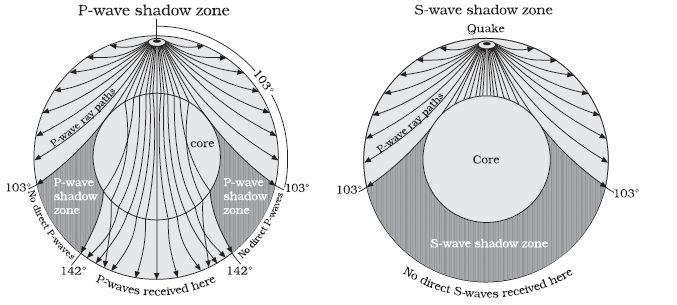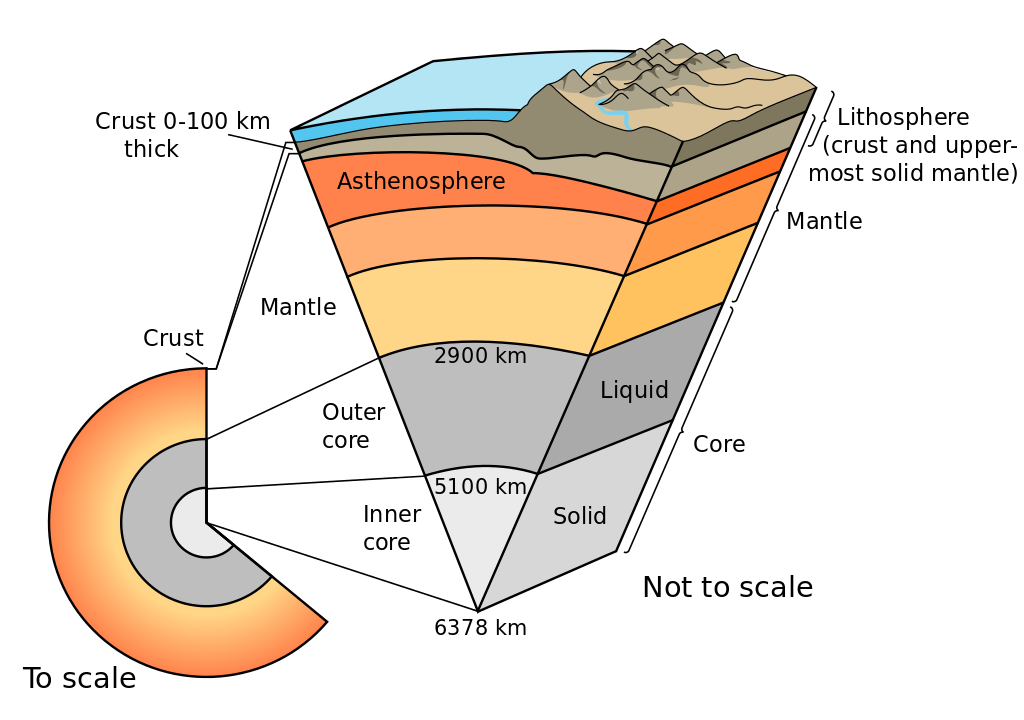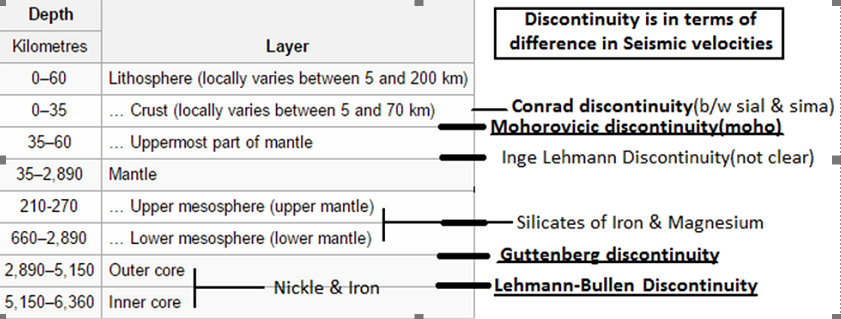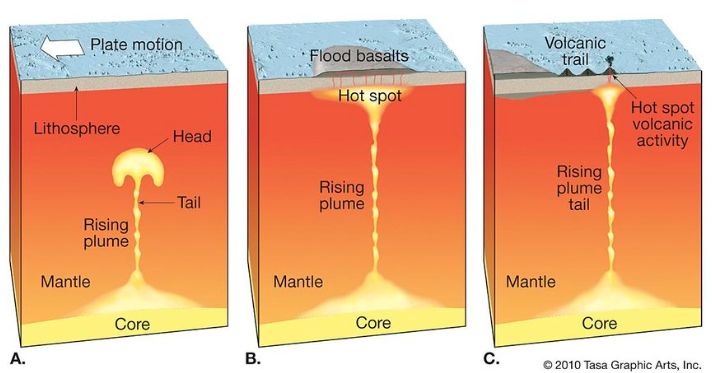Interior of Earth- UPSC Notes
Geologists and seismologists have been concerned about what constitutes the earth. Earth is not a homogeneous solid ball, it consists of different layers with different characteristics. Various processes in the earth’s interior affect the landforms, which indirectly affect people’s lives.
Thus, we study the interior of earth as it helps in:
- To study the physiographic characteristics of the region, we have to study various endogenic processes in the earth. Earth’s surface is essentially a product of processes operating in the interior of the Earth.
- Endogenic Processes (beneath surface): The endogenic process is an internal geomorphic process. The energy emanating from the earth is the main force behind endogenic geomorphic processes. This energy is mainly generated by radioactivity, rotational and tidal friction and primordial heat from the origin of the earth.
- Exogenic (on the surface) processes constantly shape the earth. Exogenic processes include geological processes and phenomena originating externally to the earth’s surface. They are genetically related to the hydrosphere, atmosphere and biosphere and, therefore, to weathering, erosion, transportation, deposition, denudation processes, etc.
- To study earthquakes: Earthquakes occur in the Lithosphere, 200 km from the earth’s surface.
Interior of Earth
Sources of Information about the Interior: There are various sources of information about the interior of the Earth, which are classified into direct and indirect sources.
- Direct Sources: They are accessible for direct observation. For example, volcanoes, mining projects, drilling projects, etc.
- Mining: It is the most abundant source of information.
- Some Gold mines in South Africa are 3-4km deep. The materials from these are used as a direct source.
- Coalmines are used as a direct source of earth analysis.
- Scientific projects: some scientific projects are undertaken to penetrate deeper depths to explore conditions in crustal portions, for example:
- Deep Ocean Drilling Project
- Integrated Ocean Drilling Project. The deepest drill at the Kola Peninsula, Arctic Ocean, has reached a depth of 12km.
- Volcanic eruptions: Magma thrown out is readily available to us for observation. However, it is challenging to reach a certain depth of Magma.
- Indirect Sources: They are materials that are not accessible for direct observation. For example, meteorites are available in space, materials are present in the core of the Earth, etc.
- Pressure and Temperature: Knowing that temperature and Pressure increase with depth and density increase. It is possible to find the rate of change of these characteristics with the thickness of the earth. Values of Temperature, Pressure and density have been estimated at different depths with the help of the rate of change of the temperature and pressure with depth.
- Meteors: It also acts as an indirect source as meteors have material similar to Earth.
- Gravitational, magnetic field and Seismic activity.
- Uneven distribution of mass and density affects gravity, which is greater near the poles. Such gravity anomalies give information about the distribution of material mass in the earth’s crust.
- Magnetic surveys give information about the distribution of magnetic materials in the crustal portion.
- Seismic activity: Seismic waves provide a complete picture of a layered interior.
Earthquakes and Earth’s Interior:
The propagation of Earthquakes tells us a lot about the internal structure of the Earth. For this, let’s study how Earthquake waves propagate through the Earth.
| Earthquakes |
|
An earthquake isdefined simply as the shaking of the earth, caused due to release of energy, which generates waves that travel in all directions. There can be broadly five reasons for the shaking of the earth. We’ve covered Earthquakes in chapter 7 in detail. Basic Definitions related to Earthquakes:
Tectonic earthquakes are caused by Fracture, i.e. a break in rock. Fractures can be of two types:
Earthquake waves can be classified into two broad categories:
Note: We shall study them in detail in chapter 4. |
Propagation of Earthquake waves:
Each of these earthquakes registers their shaking all over the earth, including the opposite end of the globe. These waves make different diagrams on the seismogram in different areas. Studying these diagrams gives us the following insights about the structure of the earth.
Emergence of Shadow Zone:
A seismic shadow zone is an area on the Earth’s surface where seismographs cannot detect direct P and S waves from an earthquake. S waves and P waves have different shadow zones. It can be discussed as follows:
- Seismographs located at any distance within 1050 from the epicentre recorded the arrival of both P and S Waves.
- Beyond 1450 from the epicentre – the arrival of only P wave and not S-Wave (can’t get past liquid)
- Shadow Zone: 1050-1450 with respect to epicentre.
- The S-Wave’s shadow is larger in extent and a little over 40% of the earth’s surface.

Conclusion: Knowing about how the waves behave as they move through different earth materials enables us to learn about the layers that make up the Earth. Seismic waves show that the Earth’s interior consists of concentric layers of a thin outer crust, a mantle, a liquid outer core, and a solid inner core.
Volcanoes and Earth’s Interior:
Volcanic material is brought to the Earth’s surface in eruptions of deep volcanic material; these rocks hold clues as to what is happening beneath the Earth’s surface.
| Volcanoes |
|
Volcanoes are endogenic processes where materials like gases, ashes, and molten rock material (lava) escape to the ground from the earth’s interior. Volcanoes can be categorised into two types based on the periodicity of eruption: active and dormant or extinct.
We’ll study it in greater detail in Chapter 6. |
Material of volcanoes: Volcanic material finds its way through the weak zone of the mantle as the Asthenosphere.
- The material in the upper mantle is called Magma. Once it reaches the surface, it is called Lava.
- It contains lava flows, pyroclastic debris, ash dust, volcanic bombs and gases such as nitrogen compounds, sulphur compounds and minor amounts of chlorine, hydrogen and argon.
Structure of Earth
The earth’s interior is divided into different layers. These layers are separated from each other through transition zones. These are called discontinuities. Earth is divided by first-order discontinuity, where there is a significant change in the transmission of Seismic waves:
- First-order discontinuity: Drastic changes in seismic velocity as well as direction occur. An extremely sharp discontinuity is often termed a first-order one.
- Second-order discontinuity: When a change in seismic velocity occurs, there is a second-order discontinuity
Based on these discontinuities, the earth can be divided into three layers, Crust, Mantle and Core, as given below:
- Crust: It is the outermost solid part of the earth. It is brittle;
- Continental crust: It is generally 30 km thick, though it can go up to 70km, as in the Himalayan region. Thicker and less dense, it comprises felsic Sodium, Potassium and aluminium Silicate. Like Granite = sial. Made of rocks of density: 2.7g/cm3.
- Oceanic crust: Itis 5km thinner than the continental crust. Oceanic Basalt layer of mafic: Mg, Iron, Silicate = Sima. It was made of heavier rocks, 3g/cm3.
Conrad discontinuity: It is a separating line between the sial (outer crust) and sima (inner crust) layers of the crust.
| Lithosphere v/s Aesthenosphere |
|
- Mantle: It is the interior of the earth beyond the crust. It extends up to 2900km. It makes up 84% of the earth’s volume and is enclosed by the crust. It is the primary source of Magma. It is made up of Silicates rich in Iron and Magnesium.
- The mantle is solid because of the relative melting points of different layers and the increase in Temperature and Pressure as depth increases, having a density of 3.4g/cm3.
- Lower Mantle, with tremendous pressure, has high viscosity.


- Core: This layer is beyond the depth of 2900km. It comprises mainly Nickel (Ni) and Iron (Fe). Therefore, it is called nife and consists of 80% Iron.
- The outer Core has liquid metallic nife due to high temperature despite high pressure.
- The inner core is solid due to very high pressure, as the melting point of iron increases dramatically at high pressure. The temperature at the centre of the earth is nearly 5500° C.
- Density at a depth of 6300km is 13g/cm3. It makes up just 15% of the earth’s volume, but more than 30% of its mass. It may contain gold, platinum, and other Siderophile elements (Iron-loving, which tends to sink to the core).
It has been theorised that most of the heavier elements on the surface of the earth sank to the core before the formation of the crust. All the heavier metals that we find on the crust today are received mostly through the bombardment of meteorites since the early phases of the earth’s history, especially during the period known as the “Late Heavy Bombardment Period” (4.1 to 3.8 billion years ago).
Processes inside the earth
The Earth’s core is heated due to mainly two main reasons – primordial heat that is trapped inside the core and radioactivity of the heavier metals inside the core.
This heat is continuously transferred at a very slow pace to the Mantle. When the material in the Mantle, in contact with the core, is heated, it expands and rises by virtue of its lower density. These massive convection channels are where the material in the mantle rises. These convection currents are known as the Mantle Plumes. These plumes drive various types of seismic as well as volcanic activities on the surface of the earth.


 FAQs for the interior of earth
FAQs for the interior of earth




